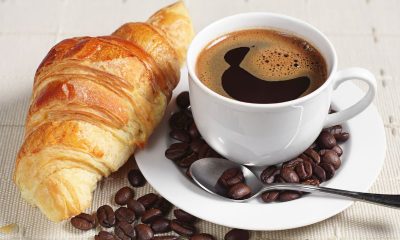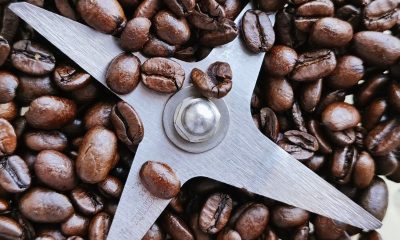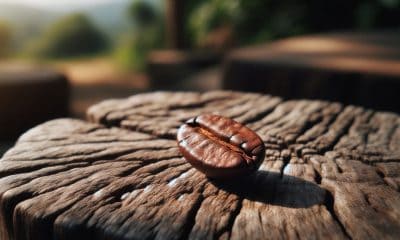Coffee Questions
How Much Caffeine is in Vietnamese Coffee? A Look Into The Surprising Energy
How much caffeine is in Vietnamese coffee? Learn what fuels this beloved and bold culinary tradition.
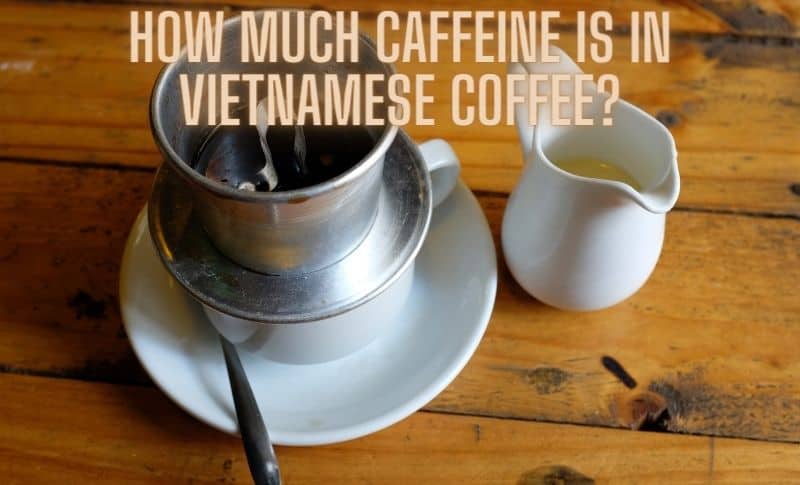

Expert Consulted: Carl. Utilizing my 6 years of experience in the coffee industry, I’m able to provide accurate and concise information, helping you make informed choices about beans, brewing methods, and equipment, thereby elevating your coffee experience. In this article, I’ll share my knowledge and experience to help you answer the question: How much caffeine is in Vietnamese coffee?
Have you ever experienced the intense flavors of Vietnamese coffee and wondered to yourself, how much caffeine am I consuming?
Well, that’s what I’ll be answering for you today in this article.
The short answer is 265mg per 8 ounces of Vietnamese coffee. This is much more than almost any other coffee you’ll find. Although it still contains less than espresso, you would have to consume roughly 4 shots of espresso to match the caffeine content in one 8-ounce cup of Vietnamese coffee. Just do not exceed 400mg of coffee in a single day.
So, let’s get into the ins and outs of Vietnamese coffee and see what it’s all about. Related article here.
Why Is There So Much Caffeine In Vietnamese Coffee?
The high caffeine content in Vietnamese coffee stems from the type of coffee bean used.
They use a popular bean called robusta, which is known for its very powerful flavors, hence why Vietnamese coffee is also known as being strong and powerful.
These beans have almost double the amount of caffeine as your typical arabica beans!
Arabica beans contain about 130mg of caffeine per 6 ounces, for reference, the same amount of coffee using robusta beans will contain 200mg.
Robusta beans have a much deeper and more intense flavor than arabica thanks to the lower lipids and natural sugars.
Typically, Vietnamese coffee is served with some sort of sweetener like sweetened condensed milk, yogurt, or even perhaps some egg whites.
These should aid in avoiding that extreme taste from the robusta beans.
Brewing Method For Vietnamese Coffee
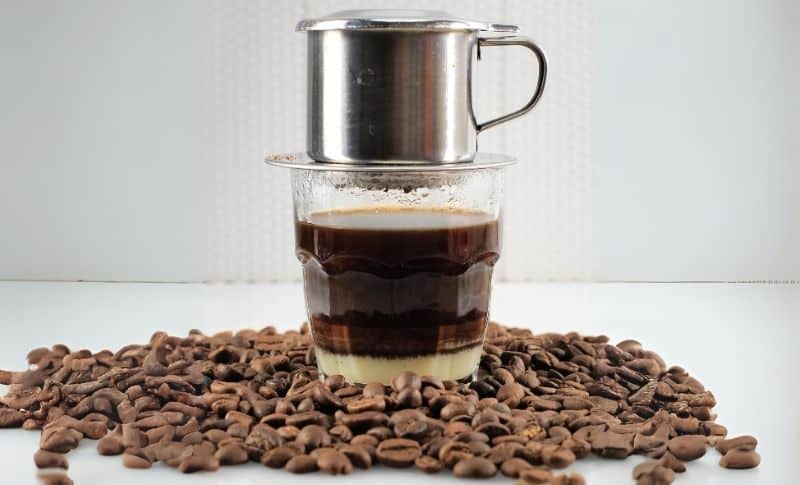
Vietnamese coffee is brewed using a unique but simple contraption called a Phin filter.
A Phin is made up of 3 main parts:
-
Metal filter
-
The brewing chamber
-
Phin cover for storing heat
Using this process will result in a longer brewing time, allowing more caffeine to be released, but if it tastes great and gets you caffeinated then you won’t mind.
To start brewing, place your ground coffee in the Phin’s bottom chamber.
Then place a metal filter on top, and proceed to percolate hot water through the metal filter’s tiny holes and right through the bottom chamber for about 4-5 minutes.
The metal filter actually contributes to a concentrated but flavorful brew. The lid keeps the coffee from evaporating too much which results in a lovely thick and intense brew.
This particular brewing method helps balance the caffeine content, and those harsh bitter flavors in the final cup, allowing a nicer drink overall.
Using medium-coarse coffee grounds, try to aim for a brewing time of roughly 5 – 10 minutes in order to maintain that balance.
If you’re too slow it will be over-extracted, too fast and it will be bland and sad. Nobody wants a sad coffee.
This brewing method does take much longer than most, for some examples, using an Aeropress tends to take about 2.5 minutes, a French press will take 4 – 5 minutes, and a Moka pot will be around 3 – 4 minutes.
So if you’re looking for a quick brew then this method might not be for you.
Vietnamese Caffeine Content Compared
Let’s compare the caffeine content found in Vietnamese coffee to some similar coffee drinks.
|
|
Servings-wise, espresso still contains more caffeine than Vietnamese coffee, but usually you won’t drink more than one espresso at a time unless you’re wanting to stay awake for a while.
So you’re more likely to get a higher amount of caffeine from a cup of Vietnamese coffee than an espresso.
When talking about black coffee, the caffeine content varies so much because of many factors, like the type of beans used, the roast level of those beans, and the brewing method.
So it can be tough to compare the caffeine content to some of the other coffees listed.
If you would like to know a bit more about caffeine content, you can check out my other article here!
Health Concerns
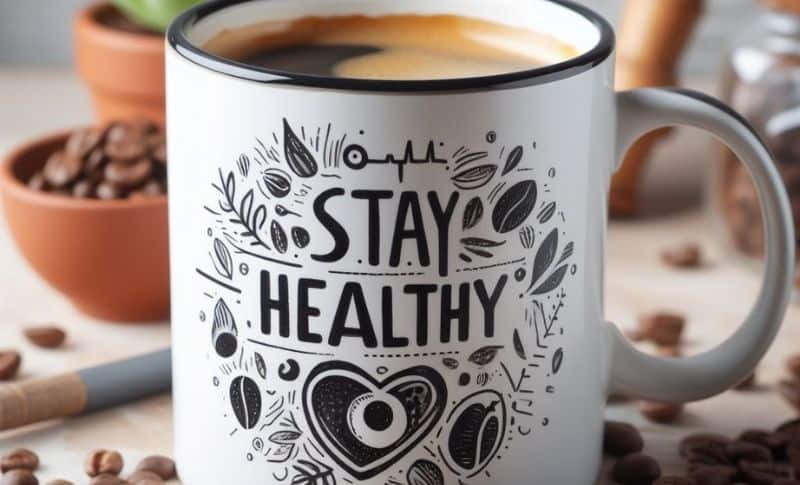
I have to talk about the dangers of consuming too much caffeine, and how much you should actually have.
It is recommended for the average adult to not consume any more than 400mg of caffeine per day. (Source)
That equals only one Vietnamese coffee per day, as one normal cup will contain 265mg of caffeine.
Also as spoken about in my article here, do not consume any more than six espresso shots in a single day, I recommend not having over four shots just to be on the safe side.
Although, if it’s imperative that you stay awake, then perhaps consider having close to 400mg.
Summary
Thank you for making it this far, below will just be a quick summary of the important points mentioned in this article.
So, the quick answer for the caffeine content in Vietnamese coffee is that it has 265 milligrams of caffeine per 8 ounces of coffee.
This is so high because of the variety of beans used, these beans are called robusta beans. These have significantly more caffeine than arabica beans but that also comes with a price, the flavor of robusta beans is a lot more potent and isn’t for the non-coffee drinker.
You’ll find that Vietnamese coffee is typically served with some sort of sweetener because of this, things like sweetened condensed milk, and egg whites are some of the popular ones.
You brew this coffee using a Vietnamese Phin filter, which is a coffee filter made from 3 main parts: a metal filter, a brewing chamber, and a Phin cover.
This brewing method helps to balance the caffeine content and any bitter flavors. The main downside of this method is that it takes a long time to brew.
To end this off, I’ll brush over the health concerns once more.
Do not have more than one Vietnamese coffee in a single day, it’s recommended to have less than 400mg of caffeine per day, so if you’re really itching for another coffee, try to have a different type like a pour over for example.
Image Attribution and Licensing
Main Image: ‘Vietnamese coffee phin’ by Jang47. (Canva Pro/Getty Images)
#1: ‘Vietnamese coffee with condensed milk’ by Ika Rahma. (Canva Pro)
#2: Made with DALL-E: 3.


